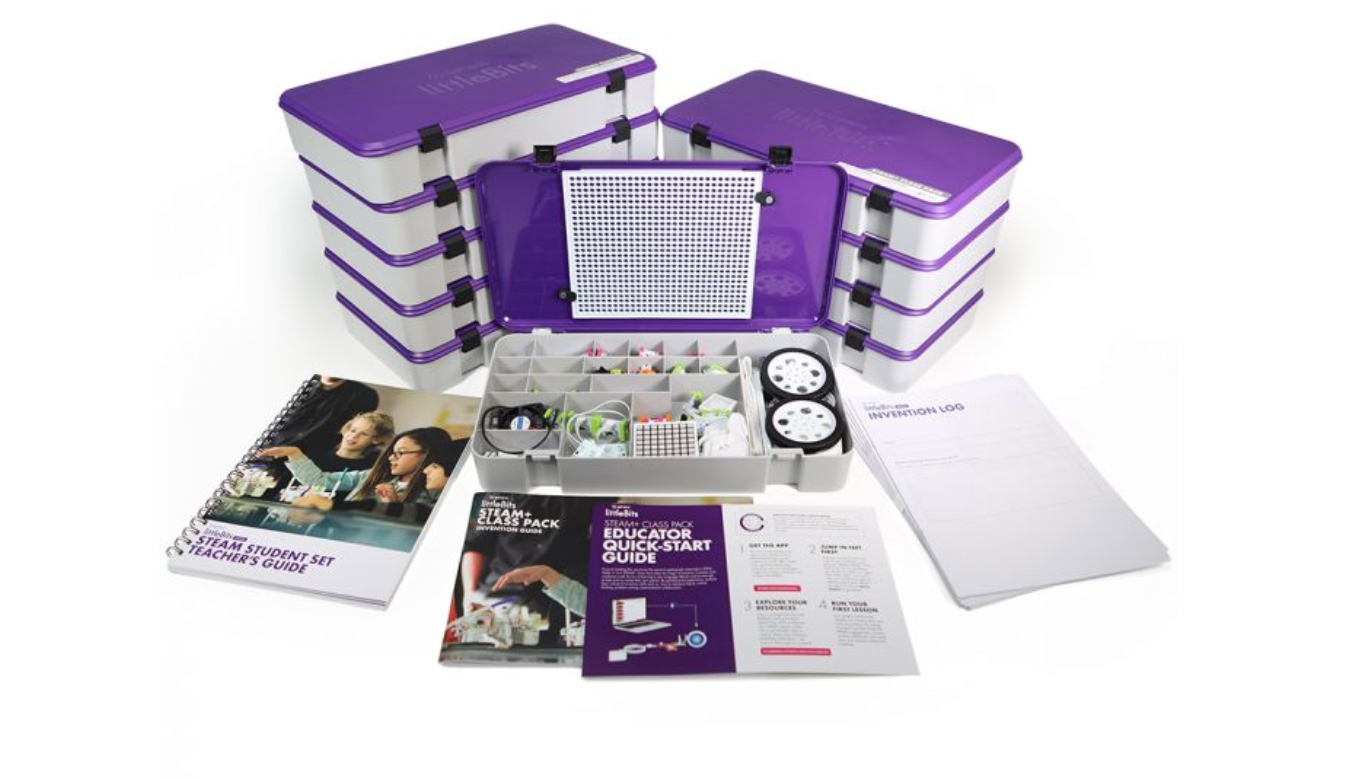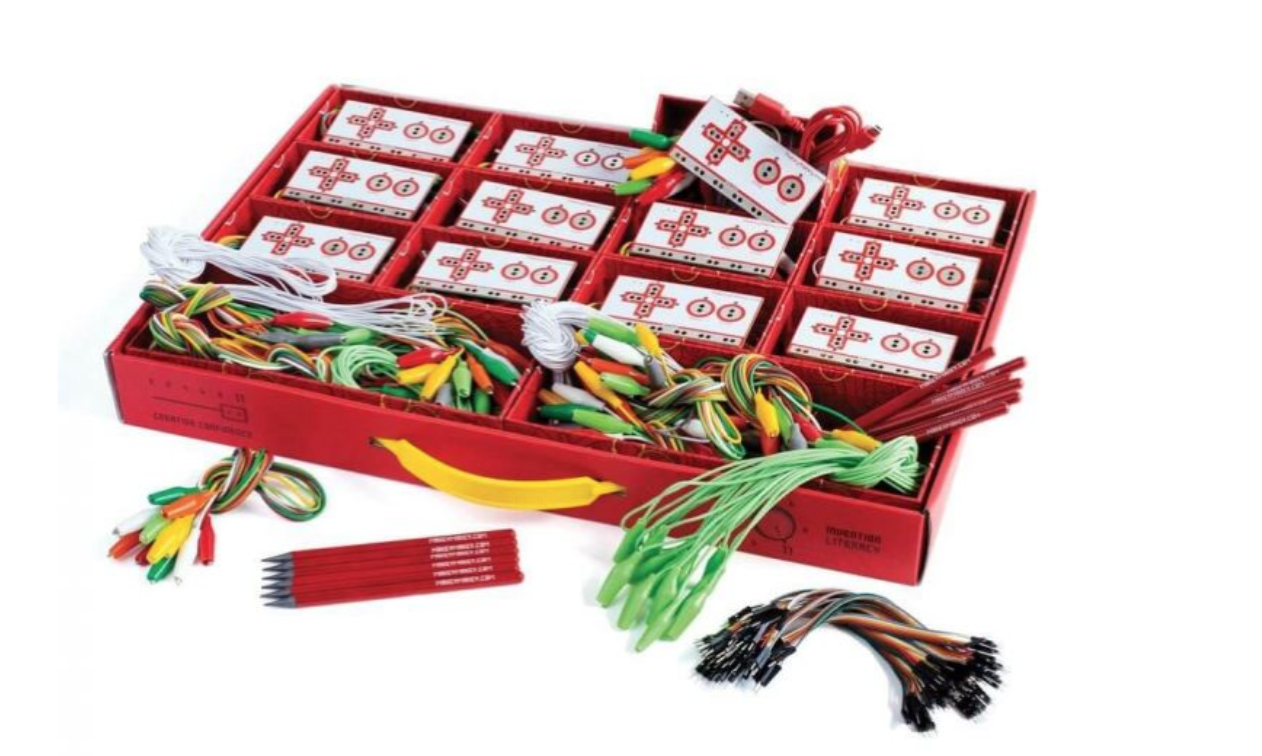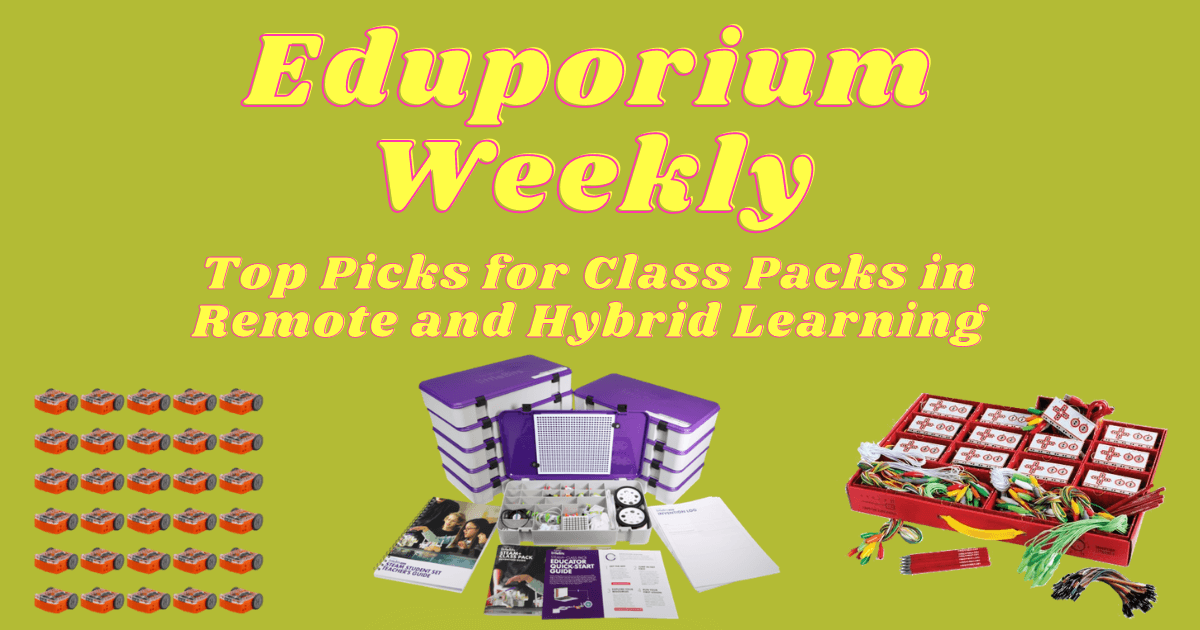As we’ve become (somewhat) more comfortable with the idea of remote and, now, hybrid learning, we are figuring out more of what works in terms of hands-on STEAM experiences for kids in different situations. At first, we were hesitant to continue highlighting class packs because they’re all on the expensive side. They also contain many moving parts and promote learning experiences in which children are touching the same components. Now the months have progressed, however, and EdTech manufacturers have actually created home learning versions of their solutions for students and educators. And, the idea of acquiring classroom packs for remote or hybrid STEM learning no longer seems too challenging or stressful. So, this week, we are sharing some of our favorite options for teachers to try!
Root Robot Classroom Packs
The Root Robot is a fantastic robotics solution for introducing CS concepts with its three progressive levels of coding. Well, that is typically how you’d use it in the classroom and, with a little bit of adaptation, it could remain viable at home—and so can the different classroom pack options. The Root Classroom Packs are available in sizes of two, six, 12, and 30 units, providing options for educators teaching classes of different sizes. Especially now, as class sizes are reduced, the 12-pack could be perfect in a lot of cases. The Root is actually for kids in all grade levels—from K-12. Plus, it’s compatible with iPads or iPhones with a virtual version available as well.
Included with the classroom packs are the corresponding number of robots, Root Academy School IDs, a printable Level 1 Curriculum Guides, foldout whiteboard grids, vinyl cling packs, USB charging cables, and dry erase markers. Since their curriculum is also accessible online, this makes for a really valuable addition that teachers can reference at home. The included Root Academy subscription provides full Root Academy access on a varying number of devices. With the 2-Pack and the 6-Pack, six devices are allowed. With the 12-Packs, 100 devices are allowed, and, with the 30-Packs, 1,000 devices are allowed! And, with the Root curriculum and activities, kids can take part in all sorts of relevant computer science lessons. They include an intro to coding, touch interaction, drawing with a Root Robot, loops and patterns, wheel speeds, color sensing, and sensing and responding.
Students could use the physical Root Robot in conjunction with the Root Coding app on iOS devices. The three levels of coding (blocks, hybrid, and text) help children quickly develop programming skills they could continue to use as they learn. These different options provide something for every student, helping to make it easier for teachers to send robots home. If students have access to a tablet at home, that would be ideal. Otherwise, educators may have to figure out a way to send devices home as well as the robots. If using the Root Coding app, children could progress to more advanced languages, like Swift, Python, and JavaScript. There’s also a virtual Root Robot, which students could use to practice coding without the physical robot. They'd just need a computer to access many of the same coding experiences they’d get otherwise!
Edison Robot EdPacks
The EdPacks, featuring the Edison Robot, are another good out-of-school, class-wide solution for STEAM learning. These convenient robotics tools check off all the boxes for STEM in remote education. They are portable, affordable, viable on a 1:1 basis, easily disinfected, and functional with or without devices and the Internet. If you’re unfamiliar with the Edison, these unique robots can read pre-created barcodes that make them do different things. For example, driving their Edison over one of those barcodes programs it to avoid obstacles. Driving it over another programs it to stay within a border. This enables students to get a feel for robotic behavior and how to use coding to create certain outcomes. Beyond that, there are plenty of ways to use it for coding or kids can attach LEGO structures to them!
Edison class packs are available in 10, 20, and 30 robots. Since these robots are so compact and come in individual boxes, it’s easy to break them up to send home. Edison charging cables come inside the battery compartments of your robots and additional materials are also easy to send home. These include batteries and the printed barcode sheets. Teachers can print the sheets and include them in packets sent home with students. They can do the same with batteries (if students have batteries at home or can print sheets, that works, too). Once they’ve got their Edison’s at home, students could immediately start to experiment with some of the functions of the robot without even needing a screen, including programming their Edison to respond to light and sound, follow lines, and avoid obstacles using the barcodes.
Beyond using barcodes, there are additional ways in which kids can learn coding with the Edison. Using a desktop or a laptop computer, there are various different online environments for students of different ages and skill levels to use in programming: EdBlocks (Blockly), EdScratch (Scratch), and EdPy (text coding with Python). All these environments are accessible online with no downloads required and students can create programs right on their screen. All the programming elements are on the left side of the screen in each one of the environments and kids could easily drag them into the programming field. Activity and project ideas for remote learning are also available on the Edison website. Once students have programs built, they can load them onto the robot using the EdComm cable and run them!

littleBits STEAM+ Class Pack
The littleBits STEAM+ Class Pack is great for distributing STEAM materials and guides from a centralized location. Though this pack has materials for 30 students, they won’t have to be in the same room to use it. In any way that works, educators can break up the components and send them home with students to use remotely. Once broken up and equally distributed, students can start building and inventing right away. The kit is compatible with screen-free, unplugged activities, but students could also choose online coding using the littleBits FUSE app. With the STEAM+ Class Pack, teachers have a genuine opportunity to replicate the hands-on nature of classroom or makerspace learning!
The STEAM+ Kit comes with 10 storage containers to make it easier to safely transport pieces. Of course, this might not be enough to send one home with every student, but at least some of them could be able to use them. The pieces are all small enough to theoretically place in plastic bags or other convenient modes of transportation. As for those pieces, there's Bits and accessories for building over 50 littleBits inventions. Among the Bits are the temperature sensor, buzzer, light sensor, slide dimmer, DC motor, speaker, and the codeBit, which is essential for students to control inventions with the FUSE app. There are 10 of each Bit except for the button and DC motor Bits, which there are 20 of. If there are more than 10 kids, instructors can allocate Bits for some while others get others and then trade.
This kit also comes with printable materials, like project guides, so teachers can send those home as well or email links for parents to print or refer to while the kids are learning. These are very valuable to allow for efficient home learning experiences that parents can help facilitate if students need assistance. Either way, kids could build many of the inventions without the need for a device (as long as they have guides printed) and lessons include many that are cross-curricular in nature as well as over 20 geared just towards coding. They align to the NGSS, CCSS, or CSTA standards with units on engineering design, science, ELA, coding, and computational thinking. To add the STEAM+ Class Pack to your repertoire, visit our store!
Sphero BOLT
The BOLT Robot from Sphero allows students in K–12 to learn coding and computer science skills in three engaging ways. They can draw programs on the screen, code using Scratch blocks, or get more complex with the text-based JavaScript language. It’s about the size of a baseball, so kids could use it in almost any environment and store and transport it easily between their home and school or from room to room as they need to. Like other Sphero robots, kids can program the BOLT with the Sphero Edu app and a device—the list of devices compatible with the BOLT is pretty long, so finding one that works shouldn’t be challenging. There's also a desktop version of the Sphero Edu app that kids can download onto their home computers.
The latest news on the BOLT and home learning is that the power packs for charging up to 15 BOLT’s at a time are versatile enough to allow for portability as well. If you're familiar with the BOLT Power Packs, they look like a rolling suitcase. It opens to reveal 15 individual inductive chargers for each robot that comes in the class pack. When connected to power, each robot charges quickly and then teachers could distribute them for hands-on coding. The beauty of the power pack is that each individual charger is removable for use as standalone charging devices. To remove the chargers, simply press the button to disconnect any that are needed and plug those into an alternate power source, which allows kids to take the robot and charger home. It's also easier to distribute the contents of the BOLT class pack for remote learning.
As for the types of activities that students can do with the BOLT robot, the opportunities are endless. When paired with the Sphero Edu app, kids can access community-created activities or get creative by designing their own. Using any appropriately sized household objects, students can build obstacle courses or design mazes for the BOLT to drive through. They can also put their coding skills to the test by creating programs that then display on their BOLT’s built-in LED matrix, adding interactivity to STEAM learning at home. Each BOLT classroom set comes with 15 BOLT Robots, 15 charging bases (separate from the Power Packs), 15 charging cables, 15 protractors, 15 sticker sheets, and 15 quick start guides. Find it on our store!

Makey Makey STEM Pack
The final list of class pack remote learning recommendations we’ll throw out this week is the Makey Makey STEM Pack. It’s not as involved as other class packs in the Hybrid & Remote section of our store but does offer the tried and true engagement and simplicity that Makey Makey-using teachers appreciate. One other thing we should mention is that the Makey Makey STEM Pack doesn't come with curriculum or any project guides—only those materials kids need to design and complete projects. The Makey Makey itself is a small computer interface that has connection ports for jumper wires and it uses the natural conductivity found in humans and other everyday objects to allow students to create their own circuits! And, honestly, there is a high probability you have no idea what's conductive, creating a fine chance to show kids.
While projects aren't included (the individual boards come in a compact cardboard box), there are lots on their website. So many students and makers have used the Makey Makey in incredibly creative ways and you can find plenty of inspiration on the Makey Makey site, on YouTube, and on other teacher and maker sites. As for the STEM Pack, it’s more affordable compared to some of the other class packs suitable for remote learning. Coming in at just under $700, the Makey Makey STEM Pack could allow educators to purchase two or three to ensure that each student gets a board and all of the other components to work with from home. Plus, the Makey Makey is also compatible with STEAM tools in other product lines, like Electric Paint, littleBits, and Strawbees.
As we'd said, the STEM Pack includes 12 individual Makey Makey packs—all neatly separated within their own boxes. Within each box is the Makey Makey board, alligator clips, connector wires, six extra clips, and the Makey Makey pencil. Broken down over the entire class pack, there are 12 Makey Makey’s, 12 alligator clips, 12 connector wires, 72 extra alligator clips, 144 connector wires, and 12 conductive pencils. It's easy to send materials home and even include other elements like scrap paper if possible. Whatever works best for your situation, the Makey Makey STEM Pack is another good option for hybrid and remote STEAM!
For the latest EdTech, STEM, and 21st century education news, follow us on Twitter and Instagram. Like us on Facebook, too, or sign up for our newsletter for our latest product announcements and offerings. If you have an idea for an Eduporium Weekly theme, send us a message on social media or comment below.



